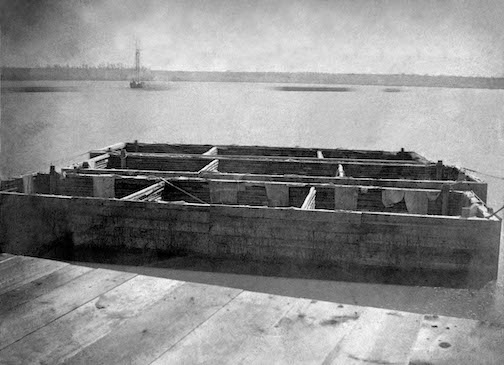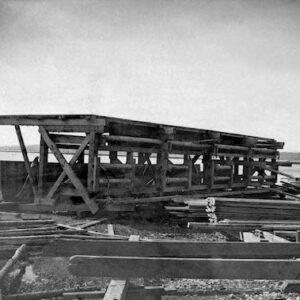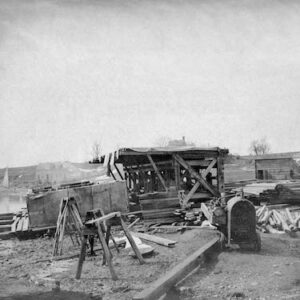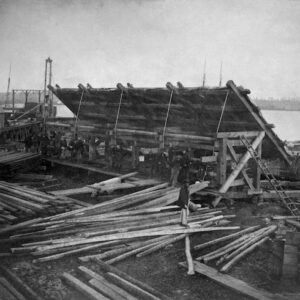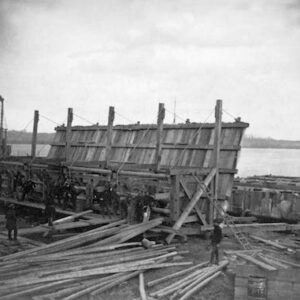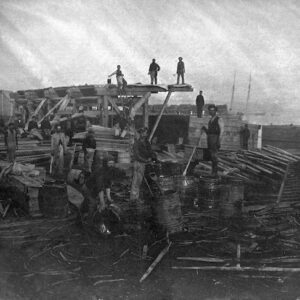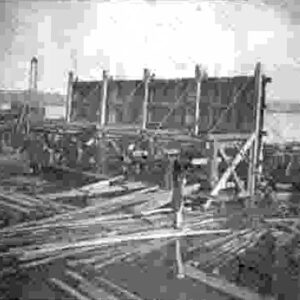| Credit: | by Russell (Andrew J.) |
|---|---|
| Date: | 1863.02-03 |
| Negative Size: | 6.5 in. x 8.5 in. |
| Locations & Lines: | Alexandria VA; Potomac River; Virginia |
| Military Units: | US Military Railroads (USMRR); US Army |
| Transports: | ark |
| Sources: | Huntington Library; J. Paul Getty Museum; Library of Congress |
$5.99
File Details: AAADm, 600 DPI, TIFF, Original Photograph, 16.9 Mb
Image ID: AAAD
Haupt, United States Military Railway Department. Construction And Transportation. No. 4. Represents arks 60 feet long, 20 feet wide, and from 6 to 8 feet high. The sides are formed of round sticks, flatted where they come together, and about 6 inches in diameter. The sticks are connect by spikes and treenails. Two-inch planks are spiked vertically on the crib-work, covered with two thicknesses of canvas, coated on both sides with pitch, and the canvas then covered with boards.
These arks may be used for a great variety of purposes connected with army transportation, some of which are as follows:
1. Transport for carrying lumber, commissary or quartermasters stores.
2. Lashed together in lots of four, forming a float 120 feet by 40 feet, they will carry 16 cars, which constitute a full train on the Virginia railroads, and all the cars can be loaded and unloaded without changing the position of the float.
3. Five arks, placed side by side, and covered by a canvas roof, will form a warehouse 100 feet by 60 feet, from which supplies may be issued; and when empty, the warehouse itself may be towed to the depot to be re-filled. Such a warehouse is now in progress of construction by the railway department as a model, to be used for ordnance stores, to be anchored in the stream at a safe distance from shore.
4. Placed together, end to end, they form a wharf sufficiently wide for two railway tracks, upon which trains can be safely run; and the capacity for loading or unloading vessels may be increased to any desired extent by increasing the number of floats at the end of the wharf. In case of evacuation, the wharves and floating warehouses may be towed to a place of safety, rendering the destruction of buildings and stores unnecessary.
5. Built about 8 feet high, with a roof of logs, they may be used as floating block-houses, for the transportation of troops on rivers, where ordinary transports would be exposed to fire from the banks; or for the protection of warehouses and other property at river landings.
6. Filled with bunks, they may form floating hospitals or may be used for accommodation of mechanics and laborers employed at river landings.
7. The weight of a locomotive engine will be depress an ark about 8 inches; they may therefore be used to support railway bridges capable of carrying trains across wide and deep streams. The spans may be built in advance on the arks, one to each end towed into position, fastened together, anchored in any suitable way, and a railway communication opened in a very short time. A draw in such a bridge can be formed by making a span movable.
Near the railroad wharf, Alexandria, VA
